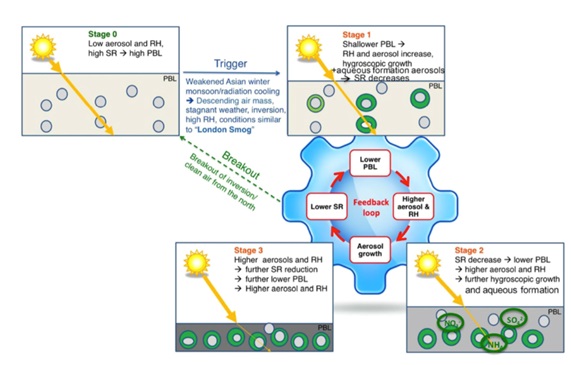
In recent years, severe haze events often occurred in China, causing serious environmental problems, and North China Plain was one of the heavy areas of haze pollution.
Mechanisms responsible for the haze formation, however, are still not well understood, hindering the forecast and mitigation of haze pollution.
Through analyzing the 2012-2013 winter haze events in Beijing, a research team led by Prof. TIE Xuexi from the Institute of Earth Environment (IEE) of the Chinese Academy of Sciences together with international partners presented that water vapour in the atmosphere played an important role in enhancing haze pollution in Eastern China.
With the combination of observation and model methods, the study illuminated that under weak solar radiation and stagnant moist meteorological conditions in winter, water vapour molecules and fine particles in the atmosphere accumulated in a shallow planetary boundary layer (PBL).
Also, vertical diffusion of water vapour molecules and fine particles was limited, which caused rapid growth of them in the shallow planetary area.
Meanwhile, the grown water vapour molecules were adsorbed on the surface of particles and formed a particulate water vapour surface layer, which caused a positive feedback cycle in the formation of heavy haze: 1) The solar radiation reflection and scattering of particles were increased, and the suppression effect in the PBL was enhanced. 2) A reaction interface of secondary particles was provided, which reinforced the formation of particles.
"The process of amplification of the water vapour is a rapid cycle and feedback process, which plays a critical role in the explosive growth of haze pollution. And it is also an important reason for the frequent haze in autumn and winter of China, especially in North China Plain." says TIE.
The study deepened the research on the reasons of regional haze pollution in China, explained the quantitative effects of water vapour on regional haze pollution, and also provided a warning for the treatment of haze pollution under high humidity background.
Their work was published in Scientific Reports.

Fig.1 Feedback mechanism amplifies the formation of heavy haze events by aerosol uptaken water. (Image by TIE et.al)

86-10-68597521 (day)
86-10-68597289 (night)

86-10-68511095 (day)
86-10-68512458 (night)

cas_en@cas.cn

52 Sanlihe Rd., Xicheng District,
Beijing, China (100864)

